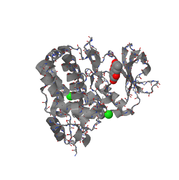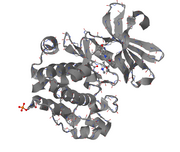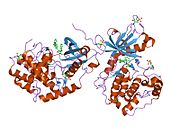BIM-1
This article may be confusing or unclear to readers. (June 2024) |

| |
| Names | |
|---|---|
| IUPAC name
3-{1-[3-(Dimethylamino)propyl]-1H-indol-3-yl}-4-(1H-indol-3-yl)-1H-pyrrole-2,5-dione
| |
| Other names
RBT205 INHIBITOR, BI1
| |
| Identifiers | |
3D model (JSmol)
|
|
| ChemSpider | |
| DrugBank | |
| ECHA InfoCard | 100.122.321 |
| EC Number |
|
| MeSH | bisindolylmaleimide |
PubChem CID
|
|
| UNII | |
CompTox Dashboard (EPA)
|
|
| |
| |
| Properties | |
| C25H24N4O2 | |
| Molar mass | 412.493 g·mol−1 |
| Appearance | Orange solid |
| Density | 1.3 g/cm3 |
| Melting point | 208 to 210 °C (406 to 410 °F; 481 to 483 K) |
| Solubility in DMSO | Soluble[vague] |
Except where otherwise noted, data are given for materials in their standard state (at 25 °C [77 °F], 100 kPa).
| |
BIM-1 (GF 109203X) and the related compounds BIM-2, BIM-3, and BIM-8 are bisindolylmaleimide-based protein kinase C (PKC) inhibitors. These inhibitors also inhibit PDK1 explaining the higher inhibitory potential of LY33331 compared to the other BIM compounds a bisindolylmaleimide inhibitor toward PDK1.[1][2]
Function
[edit]BIM-1 is present in the structure of PKCiota[3] (residue 574-turn[4] motif). It needs to be phosphorylated towards a PKCbeta-specific inhibitor site-directed mutagenesis of the compound for its full activation[5] and co-crystallized as an asymmetric pair which is mediated by 3-phosphoinositide-dependent protein kinase-1 (PDK1)[6] are downstream characteristics of PKCs and PKB/AKT.[7]
Scope
[edit]The bound BIM-1 inhibitor blocks bilobal[8] interactions, the ATP-binding site, features an ATP-competitive inhibitor, 2-methyl-1H-indol-3-yl-BIM-1,[8] the crystal structure[8] and catalytic subunit with a 20-amino acid substrate analog inhibitor structure is bilobal MgATP a transport protein that provide a more precise description of which is influenced by lobe-lobe interactions binding in cells expressing both forms a pair of kinase-inhibitor complexes[7] with ferritin in a soluble and non-toxic form (Poisson-Boltzmann[9]) and a portion of the inhibitor peptide[10] a lysine residue, has been shown to be involved in ATP binding.
Interactions
[edit]The PKCiota-BIM-1 complex[4] interacts with the zinc finger of lambda/iota PKC characterization of lambda-interacting protein (LIP)[5] (lambda-interacting protein; a selective activator of lambda/iota PKC). Phosphorylation of a PKC induces a conformation leading to import of a PKC into the nucleus.[11] The entire 587-amino acid coding region of a new PKC isoform, PKC iota.[11] Where Thr-412[5][12] (activation loop of the kinase domain) at PKCiota/lambda phosphorylates glyceraldehyde-3-phosphate dehydrogenase (GAPDH)[13] that sort cargo to the anterograde pathway[14] the phosphorylation pathway(s) involved in this phenomenon[2] mimic glutamate and can adopt two limiting diastereomeric (syn and anti) conformation[15] biosynthetically related indolocarbazole analogs[16] and in Proto-oncogene serine/threonine-protein kinase Pim-1-Peptide as a phosphorylation target including itself. The bound BIM-1 inhibitor blocks the ATP-binding site and puts the kinase domain into an intermediate open[7] conformation.[4] The value of such calculations lies in understanding[9] a variant was designed which showed improved binding characteristics[17] of configurationally stable atropisomeric bisindolylmaleimides[15] where the two kinase domains, and two different inhibitor conformers bind in different orientations,[7] the hinge region of staurosporine[18]-Pim-1 resembles[19] co-crystallized[8] as an asymmetric pair of biosynthetically 'related' indolocarbazole analogs. It is a modulator of the 5-HT2A receptor.[20]
References
[edit]- ^ Komander D, Kular GS, Schüttelkopf AW, Deak M, Prakash KR, Bain J, Elliott M, Garrido-Franco M, Kozikowski AP, Alessi DR, van Aalten DM (February 2004). "Interactions of LY333531 and other bisindolyl maleimide inhibitors with PDK1". Structure. 12 (2): 215–26. doi:10.1016/j.str.2004.01.005. PMID 14962382.
- ^ a b Cartee L, Smith R, Dai Y, Rahmani M, Rosato R, Almenara J, Dent P, Grant S (June 2002). "Synergistic induction of apoptosis in human myeloid leukemia cells by phorbol 12-myristate 13-acetate and flavopiridol proceeds via activation of both the intrinsic and tumor necrosis factor-mediated extrinsic cell death pathways". Mol. Pharmacol. 61 (6): 1313–21. doi:10.1124/mol.61.6.1313. PMID 12021392.
- ^ Baldwin RM, Parolin DA, Lorimer IA (June 2008). "Regulation of glioblastoma cell invasion by PKC iota and RhoB". Oncogene. 27 (25): 3587–95. doi:10.1038/sj.onc.1211027. PMID 18212741.
- ^ a b c Messerschmidt A, Macieira S, Velarde M, Bädeker M, Benda C, Jestel A, Brandstetter H, Neuefeind T, Blaesse M (September 2005). "Crystal structure of the catalytic domain of human atypical protein kinase C-iota reveals interaction mode of phosphorylation site in turn motif". J Mol Biol. 352 (4): 918–31. doi:10.1016/j.jmb.2005.07.060. PMID 16125198.
- ^ a b c Diaz-Meco MT, Municio MM, Sanchez P, Lozano J, Moscat J (January 1996). "Lambda-interacting protein, a novel protein that specifically interacts with the zinc finger domain of the atypical protein kinase C isotype lambda/iota and stimulates its kinase activity in vitro and in vivo". Mol Cell Biol. 16 (1): 105–14. doi:10.1128/mcb.16.1.105. PMC 230983. PMID 8524286.
- ^ Peifer C, Alessi DR (December 2008). "Small-molecule inhibitors of PDK1". ChemMedChem. 3 (12): 1810–38. doi:10.1002/cmdc.200800195. PMID 18972468. S2CID 29838120.
- ^ a b c d Gassel M, Breitenlechner CB, König N, Huber R, Engh RA, Bossemeyer D (May 2004). "The protein kinase C inhibitor bisindolyl maleimide 2 binds with reversed orientations to different conformations of protein kinase A". J Biol Chem. 279 (22): 23679–90. doi:10.1074/jbc.M314082200. PMID 14996846.
- ^ a b c d Grodsky Grodsky N, Li Y, Bouzida D, Love R, Jensen J, Nodes B, Nonomiya J, Grant S (November 2006). "Structure of the catalytic domain of human protein kinase C beta II complexed with a bisindolylmaleimide inhibitor". Biochemistry. 45 (47): 13970–81. doi:10.1021/bi061128h. PMID 17115692.
- ^ a b Page CS, Bates PA (December 2006). "Can MM-PBSA calculations predict the specificities of protein kinase inhibitors?". J. Comput. Chem. 27 (16): 1990–2007. doi:10.1002/jcc.20534. PMID 17036304. S2CID 23077429.
- ^ Knighton DR, Zheng JH, Ten Eyck LF, Ashford VA, Xuong NH, Taylor SS, Sowadski JM (July 1991). "Crystal structure of the catalytic subunit of cyclic adenosine monophosphate-dependent protein kinase". Science. 253 (5018): 407–14. Bibcode:1991Sci...253..407K. doi:10.1126/science.1862342. PMID 1862342.
- ^ a b White WO, Seibenhener ML, Wooten MW (January 2002). "Phosphorylation of tyrosine 256 facilitates nuclear import of atypical protein kinase C". J Cell Biochem. 85 (1): 42–53. doi:10.1002/jcb.10101. PMID 11891849. S2CID 221311830.
- ^ Cantin GT, Yi W, Lu B, Park SK, Xu T, Lee JD, Yates JR (March 2008). "Combining protein-based IMAC, peptide-based IMAC, and MudPIT for efficient phosphoproteomic analysis". J Proteome Res. 7 (3): 1346–51. doi:10.1021/pr0705441. PMID 18220336.
- ^ Tisdale EJ. (December 2003). "Rab2 interacts directly with atypical protein kinase C (aPKC) iota/lambda and inhibits aPKCiota/lambda-dependent glyceraldehyde-3-phosphate dehydrogenase phosphorylation". J Biol Chem. 278 (52): 52424–30. doi:10.1074/jbc.M309343200. PMID 14570876.
- ^ Tisdale EJ, Artalejo CR (March 2006). "Src-dependent aprotein kinase C iota/lambda (aPKCiota/lambda) tyrosine phosphorylation is required for aPKCiota/lambda association with Rab2 and glyceraldehyde-3-phosphate dehydrogenase on pre-golgi intermediates". J Biol Chem. 281 (13): 8436–42. doi:10.1074/jbc.M513031200. PMC 3742308. PMID 16452474.
- ^ a b Barrett S, Bartlett S, Bolt A, Ironmonger A, Joce C, Nelson A, Woodhall T (October 2005). "Configurational stability of bisindolylmaleimide cyclophanes: from conformers to the first configurationally stable, atropisomeric bisindolylmaleimides". Chemistry: A European Journal. 11 (21): 6277–85. doi:10.1002/chem.200500520. PMID 16075446.
- ^ Sánchez C, Méndez C, Salas JA (December 2006). "Indolocarbazole natural products: occurrence, biosynthesis, and biological activity". Nat Prod Rep. 23 (6): 1007–45. doi:10.1039/B601930G. PMID 17119643.
- ^ Bandeiras TM, Hillig RC, Matias PM, Eberspaecher U, Fanghänel J, Thomaz M, Miranda S, Crusius K, Pütter V, Amstutz P, Gulotti-Georgieva M, Binz HK, Holz C, Schmitz AA, Lang C, Donner P, Egner U, Carrondo MA, Müller-Tiemann B (April 2008). "Structure of wild-type Plk-1 kinase domain in complex with a selective DARPin". Acta Crystallogr D. 64 (4): 339–53. doi:10.1107/S0907444907068217. PMID 18391401.
- ^ Lee SK, Stern PH (October 2000). "Divergent effects of protein kinase C (PKC) inhibitors staurosporine and bisindolylmaleimide I (GF109203X) on bone resorption". Biochem. Pharmacol. 60 (7): 923–6. doi:10.1016/S0006-2952(00)00418-4. PMID 10974200.
- ^ M.D.Jacobs; J.Black; O.Futer; L.Swenson; B.Hare; M.Fleming; K.Saxena (May 2005). "Pim-1 ligand-bound structures reveal the mechanism of serine/threonine kinase inhibition by LY294002". J Biol Chem. 280 (14): 13728–13734. doi:10.1074/jbc.M413155200. PMID 15657054.
- ^ Minami K, Minami M, Harris RA. Inhibition of 5-hydroxytryptamine type 2A receptor-induced currents by n-alcohols and anesthetics. J Pharmacol Exp Ther. 1997 Jun;281(3):1136-43. PMID 9190846


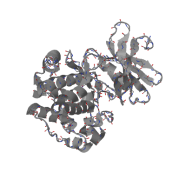
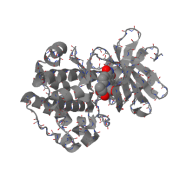
![1uu8: Two limiting diastereomeric (syn and anti) conformation cargo to the retro/anterograde pathway. Crystal structure of the human kinase domain 1uu8, 1xws & 1zrz pim1: 1xws (from-use images@ ebi refs.@ pubchem) BI1 search 3-{1-[3-(DIMETHYLAMINO)PROPYL]-1H-INDOL-3-YL}-4-(1H-INDOL-3-YL)-1H-PYRROLE-2,5-DIONE)](http://up.wiki.x.io/wikipedia/commons/thumb/3/35/1uu8-%26-spine.svg/167px-1uu8-%26-spine.svg.png)
